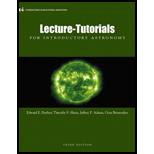
Concept explainers
Two students are discussing their answers to Questions 14 and 15.
Student 1:I think Extrasolar Planet System C shows the star with the largest Dopplershift. This is because the star in System C has the largest orbit. Thismeans that this extrasolar planet will be the easiest to detect.
Student 2:I don’t think that Doppler shift is caused by the size of the star’s orbit. Tocause a large Doppler shift, you want a low-mass star that is close to alarge-mass planet, and that is Extrasolar Planet System B.
Do you agree or disagree with either or both of the students? Explain your reasoning.
Learn your wayIncludes step-by-step video

Chapter 5 Solutions
Lecture- Tutorials for Introductory Astronomy
Additional Science Textbook Solutions
The Cosmic Perspective
College Physics
University Physics (14th Edition)
Applied Physics (11th Edition)
Sears And Zemansky's University Physics With Modern Physics
Introduction to Electrodynamics
- The best parallaxes obtained with Hipparcos have an accuracy of 0.001 arcsec. If you want to measure the distance to a star with an accuracy of 10%, its parallax must be 10 times larger than the typical error. How far away can you obtain a distance that is accurate to 10% with Hipparcos data? The disk of our Galaxy is 100,000 light-years in diameter. What fraction of the diameter of the Galaxy’s disk is the distance for which we can measure accurate parallaxes?arrow_forwardWhich of the following can you determine about a star without knowing its distance, and which can you not determine: radial velocity, temperature, apparent brightness, or luminosity? Explain.arrow_forwardSuppose there are three stars in space, each moving at 100 km/s. Star A is moving across (i.e., perpendicular to) our line of sight, Star B is moving directly away from Earth, and Star C is moving away from Earth, but at a 30° angle to the line of sight. From which star will you observe the greatest Doppler shift? From which star will you observe the smallest Doppler shift?arrow_forward
- Based upon the evolution of stars, place the following elements in order of least to most common in the Galaxy: gold, carbon, neon. What aspects of stellar evolution formed the basis for how you ordered the elements?arrow_forwardA friend of yours who did not do well in her astronomy class tells you that she believes all stars are old and none could possibly be born today. What arguments would you use to persuade her that stars are being born somewhere in the Galaxy during your lifetime?arrow_forwardDo the previous problem again, this time using the information that the Sun is 150,000,000 km away. You will get a very large number of km as your answer. To get a better feeling for how the distances compare, try calculating the time it takes light at a speed of 299,338 km/s to travel from the Sun to Earth and from Alpha Centauri to Earth. For Alpha Centauri, figure out how long the trip will take in years as well as in seconds.arrow_forward
- H II regions can exist only if there is a nearby star hot enough to ionize hydrogen. Hydrogen is ionized only by radiation with wavelengths shorter than 91.2 nm. What is the temperature of a star that emits its maximum energy at 91.2 nm? (Use Wien’s law from Radiation and Spectra.) Based on this result, what are the spectral types of those stars likely to provide enough energy to produce H II regions?arrow_forwardConsider the following data on four stars: Which star would have the largest radius? Which star would have the smallest radius? Which star is the most common in our area of the Galaxy? Which star is the least common?arrow_forwardLet us imagine that the spectrum of a star is collected and we find the absorption line of Hydrogen-Alpha (the deepest absorption line of hydrogen in the visible part of the electromagnetic spectrum) to be observed at 656.5 nm instead of 656.3 nm as measured in a lab here on Earth. What is the velocity of this star in m/s? (Hint: speed of light is 3*10^8 m/s; leave the units off of your answer) Question 4 of 7 A Moving to another question will save this response. 1 6:59 & backsarrow_forward
- 1. A distant galaxy has an apparent magnitude of 10 and is 4,000 kpc away. What is its absolute magnitude? (Round your answer to at least one decimal place.) The difference in absolute magnitude between two objects viewed from the same distance is related to their fluxes by the flux-magnitude relation. FA/FB= 2.51(MB − MA) 2. How does the absolute magnitude of this galaxy compare to the Milky Way (M = −21)?arrow_forwardThe H-R diagram is the most important graph in astronomy. One of the reasons that this graph is so powerful is the number of different kinds of data it shows. Most graphs show two types of data. The H-R diagram shows seven. Can you name these 7 types of information about stars that appear on the H-R diagram?arrow_forward"51 Pegasi" is the name of the first normal star (besides the Sun) around which a planet was discovered. It is in the constellation Pegasus the horse. Its parallax is measured to be 0.064 arcsec. a. What is its distance from us? b. The apparent brightness is 1.79 × 10-10 J/(s·m2 ). What is the luminosity? How does that compare with that of the Sun? Look up the temperature: how doarrow_forward

 Foundations of Astronomy (MindTap Course List)PhysicsISBN:9781337399920Author:Michael A. Seeds, Dana BackmanPublisher:Cengage Learning
Foundations of Astronomy (MindTap Course List)PhysicsISBN:9781337399920Author:Michael A. Seeds, Dana BackmanPublisher:Cengage Learning AstronomyPhysicsISBN:9781938168284Author:Andrew Fraknoi; David Morrison; Sidney C. WolffPublisher:OpenStax
AstronomyPhysicsISBN:9781938168284Author:Andrew Fraknoi; David Morrison; Sidney C. WolffPublisher:OpenStax Stars and Galaxies (MindTap Course List)PhysicsISBN:9781337399944Author:Michael A. SeedsPublisher:Cengage Learning
Stars and Galaxies (MindTap Course List)PhysicsISBN:9781337399944Author:Michael A. SeedsPublisher:Cengage Learning Stars and GalaxiesPhysicsISBN:9781305120785Author:Michael A. Seeds, Dana BackmanPublisher:Cengage Learning
Stars and GalaxiesPhysicsISBN:9781305120785Author:Michael A. Seeds, Dana BackmanPublisher:Cengage Learning




